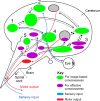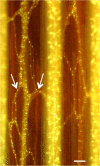Debunking a myth: plant consciousness
- PMID: 33196907
- PMCID: PMC8052213
- DOI: 10.1007/s00709-020-01579-w
Debunking a myth: plant consciousness
Abstract
Claims that plants have conscious experiences have increased in recent years and have received wide coverage, from the popular media to scientific journals. Such claims are misleading and have the potential to misdirect funding and governmental policy decisions. After defining basic, primary consciousness, we provide new arguments against 12 core claims made by the proponents of plant consciousness. Three important new conclusions of our study are (1) plants have not been shown to perform the proactive, anticipatory behaviors associated with consciousness, but only to sense and follow stimulus trails reactively; (2) electrophysiological signaling in plants serves immediate physiological functions rather than integrative-information processing as in nervous systems of animals, giving no indication of plant consciousness; (3) the controversial claim of classical Pavlovian learning in plants, even if correct, is irrelevant because this type of learning does not require consciousness. Finally, we present our own hypothesis, based on two logical assumptions, concerning which organisms possess consciousness. Our first assumption is that affective (emotional) consciousness is marked by an advanced capacity for operant learning about rewards and punishments. Our second assumption is that image-based conscious experience is marked by demonstrably mapped representations of the external environment within the body. Certain animals fit both of these criteria, but plants fit neither. We conclude that claims for plant consciousness are highly speculative and lack sound scientific support.
Keywords: Cell consciousness; Classical (Pavlovian) learning; Plant and animal consciousness; Plant electrophysiology; Proactive behavior; Reciprocal signaling.
Conflict of interest statement
The authors declare that they have no conflict of interest.
Figures









Similar articles
-
Consciousness, biology and quantum hypotheses.Phys Life Rev. 2012 Sep;9(3):285-94. doi: 10.1016/j.plrev.2012.07.001. Epub 2012 Jul 10. Phys Life Rev. 2012. PMID: 22925839 Review.
-
Anesthetics and plants: no pain, no brain, and therefore no consciousness.Protoplasma. 2021 Mar;258(2):239-248. doi: 10.1007/s00709-020-01550-9. Epub 2020 Sep 2. Protoplasma. 2021. PMID: 32880005 Free PMC article. Review.
-
Awareness and integrated information theory identify plant meristems as sites of conscious activity.Protoplasma. 2021 May;258(3):673-679. doi: 10.1007/s00709-021-01633-1. Epub 2021 Mar 21. Protoplasma. 2021. PMID: 33745091 Free PMC article.
-
Integrated information theory does not make plant consciousness more convincing.Biochem Biophys Res Commun. 2021 Jul 30;564:166-169. doi: 10.1016/j.bbrc.2021.01.022. Epub 2021 Jan 21. Biochem Biophys Res Commun. 2021. PMID: 33485631 Review.
-
Integrated information as a possible basis for plant consciousness.Biochem Biophys Res Commun. 2021 Jul 30;564:158-165. doi: 10.1016/j.bbrc.2020.10.022. Epub 2020 Oct 17. Biochem Biophys Res Commun. 2021. PMID: 33081970 Review.
Cited by
-
Vegetal memory through the lens of transcriptomic changes - recent progress and future practical prospects for exploiting plant transcriptional memory.Plant Signal Behav. 2024 Dec 31;19(1):2383515. doi: 10.1080/15592324.2024.2383515. Epub 2024 Jul 30. Plant Signal Behav. 2024. PMID: 39077764 Free PMC article. Review.
-
What Is Consciousness? Integrated Information vs. Inference.Entropy (Basel). 2021 Aug 11;23(8):1032. doi: 10.3390/e23081032. Entropy (Basel). 2021. PMID: 34441172 Free PMC article.
-
Plants make smart decisions in complex environments.Plant Signal Behav. 2021 Nov 2;16(11):1970448. doi: 10.1080/15592324.2021.1970448. Epub 2021 Aug 29. Plant Signal Behav. 2021. PMID: 34459354 Free PMC article. Review.
-
A Traditional Scientific Perspective on the Integrated Information Theory of Consciousness.Entropy (Basel). 2021 May 22;23(6):650. doi: 10.3390/e23060650. Entropy (Basel). 2021. PMID: 34067413 Free PMC article.
-
How to Live in the Moment: The Methodology and Limitations of Evolutionary Research on Consciousness.Cogn Sci. 2025 Mar;49(3):e70053. doi: 10.1111/cogs.70053. Cogn Sci. 2025. PMID: 40105062 Free PMC article.
References
-
- Abbas AK, Lichtman AH, Pillai S. Basic immunology: functions and disorders of the immune system. 6. New York: Elsevier Health Sciences; 2019.
-
- Alberts B, Johnson A, Lewis J, Morgan D, Raff M, Roberts K, Walter P (2014) Molecular biology of the cell, 6th edn. Garland Science, New York
Publication types
MeSH terms
LinkOut - more resources
Full Text Sources

